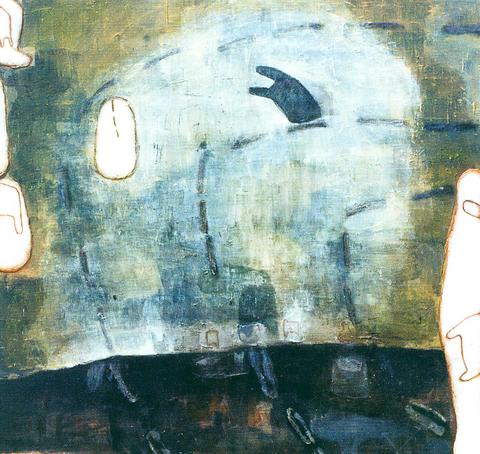Can memories be laid out on plates, each marked a different year, and exhibited in a gallery? Chang Kuang-chi (
Expansible Segments (演.譯.段落) shows 40 works of acrylic and mixed media on canvases meant to present her memories.

When studying in the US two years ago, Chang went to an exhibition of the ecological systems of prehistoric creatures. In transparent boxes were reconstructed strata with models of various animals on each stratum, with each box representing an era from the past. The history of the earth's ecological systems came to life before her eyes.

PHOTOS COURTESY OF TFAM
Despite her strong interest in insects and small animals since childhood, Chang had never seen these creatures in this way. "They were the kind of creatures you could not see when they were alive, but in those boxes, they were as if alive in their own environment," Chang said. Coming face to face with reconstructed ecosystems eons ago inspired her to do the same with her memories.
Using acrylic and other materials to creat a texture similar to earth strata, Chang put down on the canvass personal symbols and imageries drawn from her memories. However, "You can never be sure your memories are what they are. Neither can you preserve them intact," Chang said. Therefore, there are only "imitated memories."

In the namesake series, fragmented, multiplied or reversed shapes strewn about the canvasses gives viewers a feeling of deja vu.
Another inspiration for her is the fieldwork she did for a book about ecosystems. Many underwater plants, Chang learned, flower above water. Their huge underwater stems and roots gradually rot in order to generate nutrition, which then allows the flowers to bloom.
For Chang, that is how her memories of the past break down and transform into the creative energy she uses in her creations today.
At a time when installation art is extremely popular, Chang insists on working on paintings because, she said, it's the most foundamental art form and a medium she can work with all her life.
To deal with the usual lack of interaction between paintings and their surroundings, Chang made irregular canvasses. The shadows created by the irregular edges of the paintings gives them a livelier presence in the gallery.
What: Expansible Segments -- Chang Kuang-chi solo exhibit
Where: Taipei Fine Arts Museum,181 Chungshan N. Rd., Sec. 3, Taipei
When: Through Oct. 6

June 2 to June 8 Taiwan’s woodcutters believe that if they see even one speck of red in their cooked rice, no matter how small, an accident is going to happen. Peng Chin-tian (彭錦田) swears that this has proven to be true at every stop during his decades-long career in the logging industry. Along with mining, timber harvesting was once considered the most dangerous profession in Taiwan. Not only were mishaps common during all stages of processing, it was difficult to transport the injured to get medical treatment. Many died during the arduous journey. Peng recounts some of his accidents in

“Why does Taiwan identity decline?”a group of researchers lead by University of Nevada political scientist Austin Wang (王宏恩) asked in a recent paper. After all, it is not difficult to explain the rise in Taiwanese identity after the early 1990s. But no model predicted its decline during the 2016-2018 period, they say. After testing various alternative explanations, Wang et al argue that the fall-off in Taiwanese identity during that period is related to voter hedging based on the performance of the Democratic Progressive Party (DPP). Since the DPP is perceived as the guardian of Taiwan identity, when it performs well,

The Taiwan People’s Party (TPP) on May 18 held a rally in Taichung to mark the anniversary of President William Lai’s (賴清德) inauguration on May 20. The title of the rally could be loosely translated to “May 18 recall fraudulent goods” (518退貨ㄌㄨㄚˋ!). Unlike in English, where the terms are the same, “recall” (退貨) in this context refers to product recalls due to damaged, defective or fraudulent merchandise, not the political recalls (罷免) currently dominating the headlines. I attended the rally to determine if the impression was correct that the TPP under party Chairman Huang Kuo-Chang (黃國昌) had little of a

A short walk beneath the dense Amazon canopy, the forest abruptly opens up. Fallen logs are rotting, the trees grow sparser and the temperature rises in places sunlight hits the ground. This is what 24 years of severe drought looks like in the world’s largest rainforest. But this patch of degraded forest, about the size of a soccer field, is a scientific experiment. Launched in 2000 by Brazilian and British scientists, Esecaflor — short for “Forest Drought Study Project” in Portuguese — set out to simulate a future in which the changing climate could deplete the Amazon of rainfall. It is